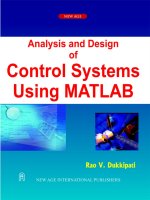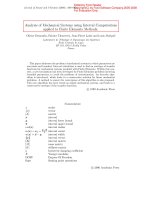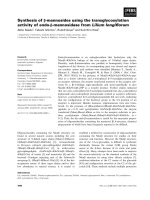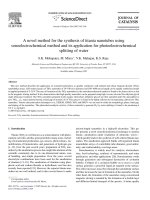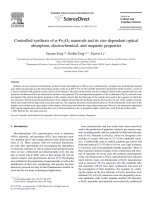ECE 574: Modeling and Synthesis of Digital Systems using Verilog and VHDL ppsx
Bạn đang xem bản rút gọn của tài liệu. Xem và tải ngay bản đầy đủ của tài liệu tại đây (599.63 KB, 8 trang )
ECE574: VHDL and Verilog Modeling and Synthesis 12/08/10 1
ECE 574: Modeling and Synthesis of Digital Systems using Verilog
and VHDL - Fall 2010
Final Exam – Verilog (6.00 to 8.30)
SOLUTIONS
This exam is in two parts.
• The first part is closed book (no books or notes allowed).
• The second part is open book (books and notes are allowed).
Read each question carefully.
Use a standard and consistent coding style.
Try and answer each question - if you consider any question to be ambiguous
then state any assumptions you make.
NAME: ___________________________
ECE Box: ________________________
ECE574: VHDL and Verilog Modeling and Synthesis 12/08/10 2
Part 1: Closed Book (No Books or Notes allowed)
Question 1 [25 marks]: A state machine used in a process control system has 3 states. It has
a clock and an asynchronous (active high) reset signal, one input called sensor and one output
called valve. The valve output is high in state S1 or S2. The next state/output table is:
Current State sensor
valve
0 1
S0 S0 S1 0
S1 S1 S2 1
S2 S0 S0 1
S*
Draw a state diagram of the state machine.
Write a synthesizable description of this controller. Use a standard two always statement
style. Describe the output logic using a separate assign statement.
ECE574: VHDL and Verilog Modeling and Synthesis 12/08/10 3
Question 2 [20 marks]: Write the Verilog synthesizable module description of a counter
with an asynchronous reset (active high) signal. The counter should count from 7 to 77 on a
negative edge of the clock and then restart at 7.
ECE574: VHDL and Verilog Modeling and Synthesis 12/08/10 4
Question 3 [20 marks]: An FPGA running off its own local 100MHz oscillator is connected
to a GPS device in another system with its own clock. The GPS device generates a 1PPS (one
pulse per second) signal that is high for approximately 10us in duration that it sends to the
FPGA.
It is necessary for the FPGA to generate a single 10ns pulse each time it detects the 1PPS
pulse.
Write a synthesizable module for the FPGA that will convert the 10us pulse from the GPS
device clock domain into the 10ns pulse inside the FPGA. The start of the module description
is provided:
module gps_pps (
input clk,
input pps_long,
output pps_short
);
ECE574: VHDL and Verilog Modeling and Synthesis 12/08/10 5
Question 4 [35 marks]: Write a Verilog model of an SRAM memory device with the
following specifications:
Address bus - 9 bits
Data bus - 8 bits
Active low control signals: CE, OE, WE
Read operation (CE and OE valid):
In the model, output the correct data only after an access time of tacc from OE and CE.
Write operation (CE and WE valid - write data on the rising edge of WE)
In the model check that the address bus is stable for taddr and the data bus is stable for tsetup
before the rising edge of WE.
If they do not meet these requirements then issue appropriate error messages.
Use parameters for the access, address, and setup times with default times of 50, 70, and 25
ns.
Example solution shown on next page: minor variations are OK.
ECE574: VHDL and Verilog Modeling and Synthesis 12/08/10 6
ECE574: VHDL and Verilog Modeling and Synthesis 12/08/10 7
Part 2: Open Book (Text book and Notes allowed).
NAME: ___________________________
ECE Box: ________________________
Question 1 [30 marks]:
A linear feedback shift register (LFSR) is a shift register whose input bit is a linear function
of its previous state.
The only linear function of single bits is xor, thus it is a shift register whose input bit is
driven by the exclusive-or (xor) of some bits of the overall shift register value.
The initial value of the LFSR is called the seed, and because the operation of the register is
deterministic, the stream of values produced by the register is completely determined by its
current (or previous) state. Likewise, because the register has a finite number of possible
states, it must eventually enter a repeating cycle. However, an LFSR with a well-chosen
feedback function can produce a sequence of bits which appears random and which has a
very long cycle.
Applications of LFSRs include generating pseudo-random numbers, pseudo-noise sequences,
fast digital counters, and whitening sequences. Both hardware and software implementations
of LFSRs are common.
The bit positions that affect the next state are called the taps. In the diagram the taps are
[16,14,13,11]. The rightmost bit of the LFSR is called the output bit. The taps are XOR'd
sequentially with the output bit and then fed back into the leftmost bit. The sequence of bits
in the rightmost position is called the output stream.
The state ACE1 hex shown will be followed by 5670 hex.
Design a synthesizable module to implement the LFSR in the diagram.
Assume it is driven by a positive edge triggered clk.
Assume it has an asynchronous reset to load it with the initial seed value ACE1 hex.
The output should be connected to the output of the 16th register.
ECE574: VHDL and Verilog Modeling and Synthesis 12/08/10 8
Question 2 [35 marks]: Design a state machine that is used as a security safe controller. It
has four push-button switches called ‘A’, ‘B’, ‘C’, ‘D’ and one output called ‘LOCK’. It will
open the safe when the four switches are pressed in the sequence “B,D,A,C”. If an incorrect
combination is entered then the state machine should go back to the first state after four
switches are pressed.
If the correct 4 switch sequence is entered then the lock output should go high ‘1’ to open the
safe for two seconds then back to the first state.
Assume you have a one second system clock.
Assume only one switch can be pressed at any time and every second a new switch is pressed.
Assume there is an asynchronous reset to start the controller in a first state.
• Draw a state diagram of the state machine.
Write a module description (that can be synthesized) of this state machine.
Question 3 [35 marks]: Write a Verilog test bench to test the state machine from question 2
as follows:
Assume the numbers
o 0100
o 0001
o 1000
o 0010
are in a text file on four lines. This represents the switches being pressed in the
sequence B, D, A, C
Use this text file to form the basis for your test bench to test the operation of your safe
controller. You should verify the lock output opens after the 4 switch sequence and is
closed at other times.
The test bench should send appropriate messages to the simulator console to show
what state it is in and to show what the expected and actual values for the lock output
are for each state.

